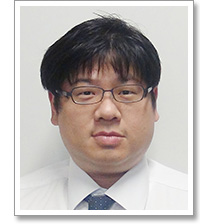| Name | Keisuke Sato |
|---|---|
| Position | Professor |
| Degree(s) | Ph.D. |
| Main Subjects | Electromagnetics and Practice I, II Electron Devices I Introduction to Tokyo Denki University Fundamental Laboratory on Electrical and Electronic Engineering I Work shop Advanced Physics and Applications of Semiconductors |

| Specialty | Semiconducting Electronic Materials Solar Power Generation and Storage Devices |
|---|---|
| Field of Research | Nanodesigning on inorganic nanoparticle surfaces Development of batteries using functional inorganic nanostructures |
| Academic Society | The Japan Society of Applied Physics The Chemical Society of Japan The illuminating Engineering Institute of Japan |
| Short Curriculum Vitae | He received Bachelor of Engineering, Master of Engineering and Doctor of Engineering degrees in electrical engineering from Tokai University, Kanagawa, Japan, in 1996, 1998 and 2003, respectively. From 2008 to 2012 he was with National Institute for Materials Science (NIMS), Tsukuba, Japan, as MANA research associate and University of Bologna (UNIBO), Bologna, Italy, as research fellow. In 2013 he joined Tokyo Denki University (TDU), Tokyo, Japan, where he is currently Professor. |
Selected Papers
- K. Kato, K. Sato, N. Fukata and K. Hirakuri: Photovoltaic performance of inorganic-organic heterojunction solar cells using boron-doped silicon nanoparticles with controlled conductance, Journal of Nanoscience and Nanotechnology, Vol. 19, No.5, p.2913-2924, 2019.
- Y. Sugano, K. Sato, N. Fukata and K. Hirakuri: Improved separation and collection of charge carriers in micro-pyramidal-structured silicon/PEDOT:PSS hybrid solar cells, Energies, Vol. 10, No.4, p.420 (13 pages), 2017.
- K. Sato, M. Dutta and N. Fukata: Inorganic/organic hybrid solar cells:Optimal carrier transport in vertically-aligned silicon nanowire arrays, Nanoscale, Vol.6, Issue 11, pp. 6092-6101, 2014.
- K. Sato, A. Castaldini, N. Fukata and A. Cavallini: Electronic level scheme in boron- and phosphorus-doped silicon nanowires, Nano Letters, Vol. 12, Issue 6, pp. 3012-3017, 2012.
- K. Sato, S. Yokosuka, Y. Takigami, K. Hirakuri, K. Fujioka, Y. Manome, H. Sukegawa, H. Iwai and N. Fukata: Size-tunable silicon/iron oxide hybrid nanoparticles with fluorescence, superparamagnetism, and biocompatibility, Journal of the American Chemical Society, Vol. 133, Issue 46, pp. 18626-18633, 2011.
Laboratory Introduction
We have taken on the challenge of developing silicon nanostructures, i.e., nanoparticles, nanoporous particles, nanowires, nanoholes, pyramid, inverted pyramid, micro-desert textures and porous-desert textures, having outstanding functions, such as high electrical conductivity and high specific surface area, by using simplified procedures based on a chemical approach. Toward the development of environmental and energy fields, we are engaged on the fabrication of novel hybrid solar cells combining functional silicon nanostructures with organic conducting polymers and novel lithium ion battery using functional silicon nanostructure anodes.








